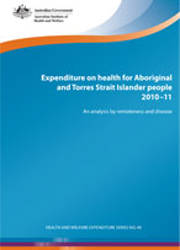Summary
This report complements Expenditure on health for Aboriginal and Torres Strait Islander people 2010-11 (AIHW 2013a) by providing a more detailed analysis of health expenditure estimates for Indigenous and non-Indigenous Australians in 2010-11. Estimates are disaggregated at the regional level, as well as for specific disease and injury groups.
Health expenditure by remoteness
Expenditure was analysed for selected health services (i.e. admitted patients, Aboriginal Community Controlled Health Services, Medicare Benefits Schedule and Pharmaceutical Benefits Scheme). For these services, for every dollar spent per non-Indigenous Australian, $1.52 was spent per Indigenous Australian and expenditure increased with remoteness for both Indigenous and non-Indigenous Australians.
The difference was greatest in Remote/Very remote areas where, for every dollar spent per non-Indigenous Australian, $2.22 was spent per Indigenous Australian. The higher expenditure on Aboriginal and Torres Strait Islander people in remote areas is mainly due to higher expenditure on admitted patient services.
Health expenditure by disease group
The disease groups that accounted for the highest proportion of admitted patient expenditure for Aboriginal and Torres Strait Islander people were genitourinary diseases ($195 million, or 11% of Indigenous admitted patient expenditure), which includes the cost of dialysis treatment, followed by mental and behavioural disorders ($191 million or 11%), unintentional injuries ($149 million or 8%) and maternal conditions ($144 million or 8%).
The largest disease group of admitted patient expenditure for non-Indigenous Australians was cardiovascular disease ($5,171 million, or 12% of non-Indigenous admitted patient expenditure).
Potentially preventable hospitalisations
Overall, for every dollar spent on potentially preventable hospitalisations (PPH) per non-Indigenous Australian, $2.22 was spent per Indigenous Australian.
The highest expenditure on PPH for Indigenous Australians was for chronic obstructive pulmonary disease ($36 million, or 16% of Indigenous PPH expenditure), followed by diabetes complications ($35 million or 16%) and cellulitis ($20 million or 9%). Expenditure on vaccine-preventable conditions was $21 per Indigenous Australian and $5 per non- Indigenous Australian.
Preliminary material: Acknowledgments; Abbreviations
1 Introduction
The effect of location on expenditure
Disease expenditure
Data sources and methods
Structure of this report
2 Expenditure by remoteness
Main findings
Expenditure per person by remoteness
Medicare Benefit Schedule and Pharmaceutical Benefits Scheme expenditure per person by remoteness
Hospital separations by remoteness
Hospital expenditure by remoteness
3 Expenditure by disease group
Total expenditure by disease group
Expenditure per person by disease group
4 Expenditure by potentially preventable hospitalisations
PPH expenditure by disease group
PPH expenditure per person by disease group
End matter: References; Related publications; List of tables



